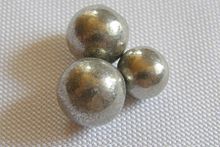Moon procedure
The after Ludwig Mond named Mond process was to clean the metal nickel developed. It is based on a chemical transport reaction .
In the general case, a solid (or more rarely: liquid) substance is reacted at a certain temperature with a gaseous transport medium and converted into a likewise gaseous product (gas phase complex). This product is then converted back into the now much purer substance and the means of transport at a different location and at a different temperature . One takes advantage of the fact that the chemical equilibrium depends on the temperature.
Refining of nickel
In the moon process the means of transport is carbon monoxide and the compound transported via the gas phase is nickel tetracarbonyl Ni (CO) 4 . The transport takes place from a cooler zone of the transport equipment (approx. 80 ° C) to a hotter (approx. 200 ° C). Nickel tetracarbonyl forms at lower temperatures and decomposes again at higher temperatures into nickel and carbon monoxide:
This fact is based on the fact that the reaction from nickel to nickel tetracarbonyl is exothermic . This means that the chemical equilibrium is on the side of elemental nickel at high temperatures. Impurities are either not brought into the gas phase at the lower temperature or they are no longer deposited at the higher temperature.
Other uses
Similar transport reactions are also used to purify some very high-melting and boiling metals such as titanium , hafnium , molybdenum and tungsten in the so-called Van-Arkel-de-Boer process . The means of transport there are halogens , especially iodine .
literature
- Ludwig Mond, Carl Langer, Friedrich Quincke : Action of carbon monoxide on nickel in J. Chem. Soc. Trans. 57 (1890) pp. 749-753; doi : 10.1039 / CT8905700749 .
- Derek GE Kerfoot in Ullmann's encyclopedia of industrial chemistry (Ed. Wolfgang Gerhartz), VCH, Weinheim, 2002.
Individual evidence
- ^ Erwin Riedel, Christoph Janiak: Inorganic Chemistry (8th edition 2011; De Gruyter). ISBN 978-3-11-022566-2 . P. 849 line 8.

![{\ displaystyle {\ ce {Ni {} + 4CO <=> [50-100 {\ text {° C}}] [180-200 {\ text {° C}}] Ni (CO) 4}}}](https://wikimedia.org/api/rest_v1/media/math/render/svg/3ac3a74361d8464464a83d2c293ae5df76f514d0)